China ore bust? Fortescue's record week
This article from Morningstar may be of interest to subscribers. Here is a section:
Eoin Treacy's view -And FMG had a pretty good week this week: its share price hit a record high of $13.28 amid growth in Chinese production, an inflated iron ore price of about US$90, and a supply shock in Brazil, which is in the grip of the coronavirus and still recovering from that deadly Brumadinho dam disaster in January last year.
Nor did the decision later in the week by China to tighten inspections on iron ore imports dampen sentiment. Will FMG’s price continue to soar? It has a steely balance sheet, good projects in train, a healthy dividend payout, and chief executive Elizabeth Gaines is adamant Chinese demand for imports remains despite the Middle Kingdom’s ore stockpiles.
But can the iron ore price keep going? Morningstar director Mathew Hodge isn’t so sure. In fact, he expects it to halve over the next few years as China’s demand moderates and Brazil recovers. His fair value estimate for FMG is $6.80, which means it’s overvalued by about 100 per cent.
“Fortescue now trades at a premium to our $12.00 bull-case valuation,” Hodge says. “Our bull case incorporates an average iron ore price to 2024 of US$74 per tonne and US$60 per tonne from 2025 onwards. This compares with our base case assumptions of US$58 to end 2024 and US$43 from 2025 onwards.”
China is ramping up its steel production because they know the only way to reinvigorate the economy is through infrastructure development. That is going to have a major technology component which is likely to require significantly more power generation capacity which is positive for steel and cement demand.
This section continues in the Subscriber's Area. Back to top



